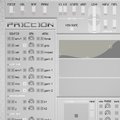xoxos has released Friction, a virtual instrument that combines a friction algorithm with a 2nd order mass-spring to model surface responsivity, and two filtered waveguides to describe primary resonances.
xoxos describes the sounds of Friction as squealing tires, squeaky hinges and axles, ww2 bombs, swingsets, etc.
Friction features
- Friction – Controls for force, velocity, grip and impedance.
- Mass-springs – two mass-springs running in series, or a 2nd order mass-spring.
- Boundaries – boundary conditions are applied to limit and reflect the first order. Separate upper and lower thresholds limit the signal like a compressor.
- Resonances – two delays are applied where the mass-spring and friction algorithms meet. These are intended for the emulation of resonant channels, such as a bar on an iron gate, the length of a swinging cable, or the volume of a chamber.
- Output – signals generated by the synthesis engine are passed through a 1- to 4-pole highpass filter positioned before the amplification envelope.
- Sends and modulation heirarchy – Sends are used to assign controllers and to route modulation sources to multiple destinations. So that modulators can be assigned to other modulation sources, a heirarchy is used, and the sends are split into groups.
- Envelopes – Up to 32 sections can be used, with a variety of contours selectable by clicking on the envelope section you wish to edit.
- LFOs – 13 waveshapes, including a stepped and smooth noise option.
- X-Y pad – Can be assigned using the send section. The rate of movement is also available as a modulation source.
- Arkecode VST Oversampler – Included wrapper that doubles the sample rate of the enclosed plugin. This allows you to improve the timbre of emulations without running all plugins at a higher sample rate.
Friction is available as a VST plug-in for Widows PC. The license is $15 USD (or $10 USD for current customers). A demo version with some parameters removed is available for download.
Visit xoxos for more information.



